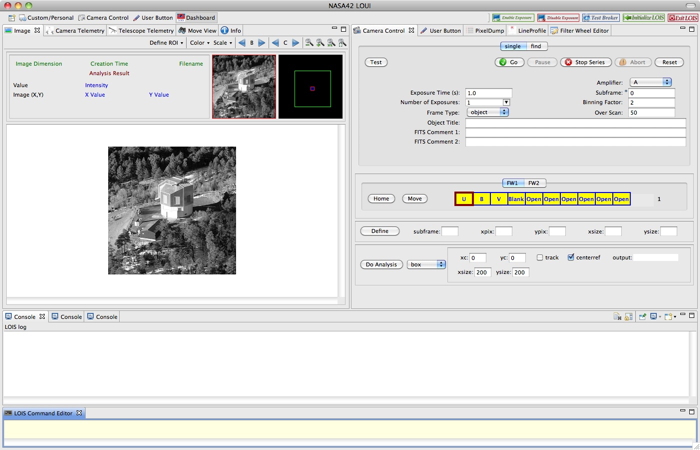
LMI: Software

The Lowell Observatory Instrument Software (LOIS) modular control system
is described by Taylor et al. 2004. Major modifications were recently made to improve its
robustness and operation across networks, with the user interface now on a separate platform-independent Java application known as the Lowell Observatory User Interface (LOUI). This has proven very reliable with the NASA42 Cam at
the 1.1-m telescope, and is in use for running HIPO on Sofia.
Some enhancement and changes for LMI were necessary:
- Integration with other DCT systems
- LMI's software needs to get basic telescope data from the DCT
(such as UT time, telescope position, catalog information).
- LMI's software needs to be able to send commands to the DCT
telescope control software to command small moves.
- LMI's filters are not perfectly parfocal, and so GWAVES will need
to piston the guider and wavefront sensors and the secondary mirror
based upon which filter is in use.
- Filter Wheel
- LMI uses a dual filter wheel; in addition, the positions of each wheel is encoded so that one always knows what position each wheel
is in, not just where the software thought it was sending the wheel. Thus
LOUI/LOIS needs to not just command the filter wheel to a particular position
but it must be prepared to read that position at the start of each exposure.
- Shutter
- The Bonn shutter provides status bits; these must be read and
displayed. (i.e., "Shutter closed" or "shutter open")
- Data storage/naming conventions
- The instrument PIs got together and agreed that some consistency
between instruments would be a Really Good Thing. Our adopted plan
can be found here.
- Headers
- Reductions:
-
The LOUI/LOIS headers are generally compatable with major software reduction codes, such as IRAF; every effort will be made to assure ease of reductions.
Current draft of FITS header words.
- World Coordinate System:
- A "pretty good" WCS should be included in the header; this will assume
a default plate scale with field center and rotation matrix
based upon the data coming back from TCS, including any rotation off of the
cardinal directions.
- Real Time Display
- LOUI/LOIS has a real time display as each image reads down. If we use
more than one amplifier, then it will be necessary to
subtract a different scalar from each quadrant to account for the different bias levels for each quadrant.
(We anticipate that the gain will be the same for each amplifier to a close approximation. If this is not the case, then we will have to Divide the data in each quadrant by different scalars.)


